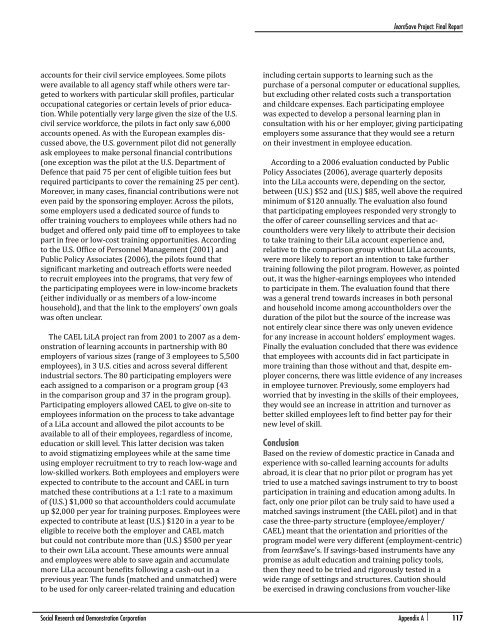Full report. - Social Research and Demonstration Corp
Full report. - Social Research and Demonstration Corp
Full report. - Social Research and Demonstration Corp
You also want an ePaper? Increase the reach of your titles
YUMPU automatically turns print PDFs into web optimized ePapers that Google loves.
learn$ave Project: Final Reportaccounts for their civil service employees. Some pilotswere available to all agency staff while others were targetedto workers with particular skill profiles, particularoccupational categories or certain levels of prior education.While potentially very large given the size of the U.S.civil service workforce, the pilots in fact only saw 6,000accounts opened. As with the European examples discussedabove, the U.S. government pilot did not generallyask employees to make personal financial contributions(one exception was the pilot at the U.S. Department ofDefence that paid 75 per cent of eligible tuition fees butrequired participants to cover the remaining 25 per cent).Moreover, in many cases, financial contributions were noteven paid by the sponsoring employer. Across the pilots,some employers used a dedicated source of funds tooffer training vouchers to employees while others had nobudget <strong>and</strong> offered only paid time off to employees to takepart in free or low-cost training opportunities. Accordingto the U.S. Office of Personnel Management (2001) <strong>and</strong>Public Policy Associates (2006), the pilots found thatsignificant marketing <strong>and</strong> outreach efforts were neededto recruit employees into the programs, that very few ofthe participating employees were in low-income brackets(either individually or as members of a low-incomehousehold), <strong>and</strong> that the link to the employers’ own goalswas often unclear.The CAEL LiLA project ran from 2001 to 2007 as a demonstrationof learning accounts in partnership with 80employers of various sizes (range of 3 employees to 5,500employees), in 3 U.S. cities <strong>and</strong> across several differentindustrial sectors. The 80 participating employers wereeach assigned to a comparison or a program group (43in the comparison group <strong>and</strong> 37 in the program group).Participating employers allowed CAEL to give on-site toemployees information on the process to take advantageof a LiLa account <strong>and</strong> allowed the pilot accounts to beavailable to all of their employees, regardless of income,education or skill level. This latter decision was takento avoid stigmatizing employees while at the same timeusing employer recruitment to try to reach low-wage <strong>and</strong>low-skilled workers. Both employees <strong>and</strong> employers wereexpected to contribute to the account <strong>and</strong> CAEL in turnmatched these contributions at a 1:1 rate to a maximumof (U.S.) $1,000 so that accountholders could accumulateup $2,000 per year for training purposes. Employees wereexpected to contribute at least (U.S.) $120 in a year to beeligible to receive both the employer <strong>and</strong> CAEL matchbut could not contribute more than (U.S.) $500 per yearto their own LiLa account. These amounts were annual<strong>and</strong> employees were able to save again <strong>and</strong> accumulatemore LiLa account benefits following a cash-out in aprevious year. The funds (matched <strong>and</strong> unmatched) wereto be used for only career-related training <strong>and</strong> educationincluding certain supports to learning such as thepurchase of a personal computer or educational supplies,but excluding other related costs such a transportation<strong>and</strong> childcare expenses. Each participating employeewas expected to develop a personal learning plan inconsultation with his or her employer, giving participatingemployers some assurance that they would see a returnon their investment in employee education.According to a 2006 evaluation conducted by PublicPolicy Associates (2006), average quarterly depositsinto the LiLa accounts were, depending on the sector,between (U.S.) $52 <strong>and</strong> (U.S.) $85, well above the requiredminimum of $120 annually. The evaluation also foundthat participating employees responded very strongly tothe offer of career counselling services <strong>and</strong> that accountholderswere very likely to attribute their decisionto take training to their LiLa account experience <strong>and</strong>,relative to the comparison group without LiLa accounts,were more likely to <strong>report</strong> an intention to take furthertraining following the pilot program. However, as pointedout, it was the higher-earnings employees who intendedto participate in them. The evaluation found that therewas a general trend towards increases in both personal<strong>and</strong> household income among accountholders over theduration of the pilot but the source of the increase wasnot entirely clear since there was only uneven evidencefor any increase in account holders’ employment wages.Finally the evaluation concluded that there was evidencethat employees with accounts did in fact participate inmore training than those without <strong>and</strong> that, despite employerconcerns, there was little evidence of any increasesin employee turnover. Previously, some employers hadworried that by investing in the skills of their employees,they would see an increase in attrition <strong>and</strong> turnover asbetter skilled employees left to find better pay for theirnew level of skill.ConclusionBased on the review of domestic practice in Canada <strong>and</strong>experience with so-called learning accounts for adultsabroad, it is clear that no prior pilot or program has yettried to use a matched savings instrument to try to boostparticipation in training <strong>and</strong> education among adults. Infact, only one prior pilot can be truly said to have used amatched savings instrument (the CAEL pilot) <strong>and</strong> in thatcase the three-party structure (employee/employer/CAEL) meant that the orientation <strong>and</strong> priorities of theprogram model were very different (employment-centric)from learn$ave’s. If savings-based instruments have anypromise as adult education <strong>and</strong> training policy tools,then they need to be tried <strong>and</strong> rigorously tested in awide range of settings <strong>and</strong> structures. Caution shouldbe exercised in drawing conclusions from voucher-like<strong>Social</strong> <strong>Research</strong> <strong>and</strong> <strong>Demonstration</strong> <strong>Corp</strong>oration Appendix A | 117




